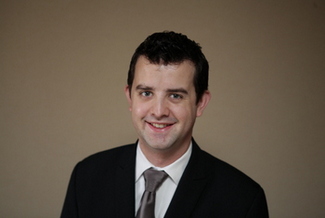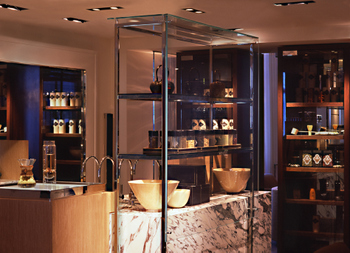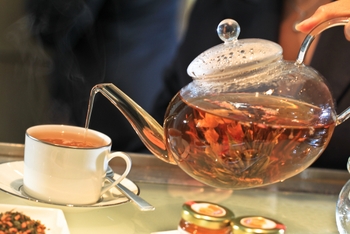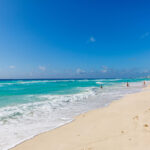Nowadays, more and more hotels are offering unique services to cater to their guests' every whim. From surf butlers to in-house tattoo artists to pet psychics, the list of luxe hotel amenities is expanding rapidly (and, many would argue, getting more ridiculous over-the-top every day). Some of these may be gimmicks — seriously, The Ritz-Carlton South Beach, tanning butlers? — but other services are more than just asterisks on amenities lists. Dedicated to their craft and eager to educate others on their field, professionals from a variety of industries have been called on by some our favorite hotels to share their expertise— and we want to hear their stories. Our Q&A series provides an inside look at some of the most fun and, oft-times surprising, services hotels offer. (Check out our first installment, with the Affinia's pet psychic, here.)

We recently interviewed Robert Rex-Waller, the resident tea expert at the Park Hyatt Washington. Tea experts, also known as tea masters or sommeliers, are growing in demand at luxury hotels around the globe. Brewing a perfect cuppa isn’t as simple as Lipton would have you believe, and that’s where experts such as Rex-Waller step in.
The Tea Cellar at the Park Hyatt Washington features over 50 rare and limited-production, single-estate teas from remote regions of China, Japan, Sri Lanka, and the Himalayas — and Rex-Waller is happy to help guests discover new, unique flavors during their visits, whether they order a calming pot of chamomile tea or a $300 pot of exclusive Pu-erh tea. Check out our interview with the tea expert after the jump.
Q: How did you first become interested in tea?
A: My father was born in Central Africa, so I grew up with English tea – full leaf – and my grandmother drank roobois consistently. So I grew up drinking black tea…What kindled the flame was the Chinese language [which I studied at university]. I traveled to China and Japan in college. I haven’t made it to India, Sri Lanka, or Tibet yet, but I would love to.
Q: How does one become a tea sommelier, or tea expert? Is there one specific term for your profession?
A: My official title is Assistant Tea and Beverage Manager at the Park Hyatt. It kind of depends on what part of the industry you work in. There is not a guild of tea sommeliers like there is with wine…there is no one to dictate who does what and what the title is. I prefer the title Tea Master.
Q: Describe your role as a tea master. Do you work in an advisory role to the Park Hyatt? Or do you work primarily with guests?
A: I work very much “front of the house.” I’m always working with guests, recommending different teas. I also work with a team of international interns who come to the Park Hyatt to learn about tea and hospitality. I still get emails and Facebook messages from interns around the world with tea emergencies.
Q: How do you go about recommending tea for guests? Do you ask them any specific questions?
A: Tea is a lot more distinctive from flavor to flavor. The untrained palate isn’t going to recognize a Bordeaux from a Cabernet, but Chinese teas have very different flavors from Japanese teas. But if you ask the right questions, you can figure out what they want.

I always begin by asking what kinds of tea guests drink at home — or what they order at Starbucks. That will automatically give me an idea of how educated the person is about teas. If they say they only drink Oolong tea, then I might suggest something more adventurous. Novice tea drinkers will use a certain language while more seasoned tea drinkers have more of an idea of what they like. We have some truly fabulous teas. I like to push people’s comfort levels.
Q: How does one brew a (nearly) perfect cup of tea?
A: Besides the tea, the water is the most important ingredient. All of our water is filtered because D.C. tap water is not known for its tasty flavor. Also, temperature — some green teas can become astringent when boiled too high, but some people want really boiling teas. We’ll do our best to make a perfect cup of tea, but it comes down to the person’s [tastes and preferences].
Q: The Park Hyatt includes a $300 pot of Pu-erh tea on its menu. What is so special about this particular strain?
A: It’s just a fermented tea. First pickings of any tea — there’s only so much of it — will raise the price. That particular tea is a wild tea leaf. There are tea farms where [the tea plant is in] neat rows and easily accessible. This 1985, however, is from a much older garden that was more haphazard. The 1980s were tumultuous times in China. Bribes to get it out of the country also raised the costs. We also offer a lovely 1978 almost as enjoyable for just $28.

Q: What is the most popular tea at the Park Hyatt?
A: Probably our very classic earl grey and black teas. People feel comfortable with that…They’re classics for a reason. One of our most popular teas is our chocolate elixir, which is brewed with four black teas, cocoa nips, and milk.
Robert Rex-Waller’s Chai Tea Recipe
A Note from Rex-Waller: “People should feel free to alter it to their own particular flavors. I find it works best with the cheese cloth, but the herbs can also be strained out after the fact.”
Ingredients:
- 15 Cardamom pods
- 2 cinnamon sticks
- 4-5 star anise
- 10 peppercorns (Rex-Waller prefers black, but any will do)
- 3 cups whole milk
- 1 teaspoon fresh ground ginger
- ½ oz loose leaf black tea (The quality is important but don’t spend a fortune, as the delicate flavors of high-end black tea will be lost with the other spices.)
Feel free to add spices like nutmeg, cocoa nibs, lemon peel, or cloves to the cheese cloth bag as well.
Instructions:
Break apart — without crushing — the cinnamon sticks, peppercorns, and anise. Make a small cheese cloth pouch and mix the spices with the ginger. Place in a small saucepan with the milk and bring to a simmer. If you wish to sweeten the tea, you may do so now with any of your preferred sweeteners, but brown sugar or sugar in the raw work best. Let them simmer for about 5 minutes. You can also add a pinch of salt at this time, but first take a taste to see how the flavors are developing — it may not need it.
Bring water to a boil in a 1-quart saucepan. Add the tea and boil for a minute or so.
Strain the tea leaves out and pour the tea into the milk mixture. Stir and serve, or refrigerate for a few days. It will keep as long as the milk is fresh.
Enjoy!
RELATED LINKS:
- Oyster Q&A: Secrets of a Hotel Pet Psychic
- The best hotel sweets for National Dessert Month — or any time of year!
- Oyster reveals some of the most over-the-top hotel amenities
All products are independently selected by our writers and editors. If you buy something through our links, Oyster may earn an affiliate commission.



